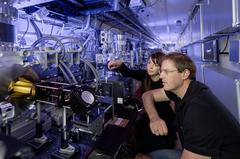URL: https://www.desy.de/news/news_search/index_eng.html
Breadcrumb Navigation
DESY News: Andreas Maier becomes lead scientist at DESY
News
News from the DESY research centre
Andreas Maier becomes lead scientist at DESY
Laser plasma acceleration is a disruptive technology for a new generation of particle accelerators that will not only be very compact, and therefore economical to build, but also highly versatile. DESY has now appointed the physicist Andreas Maier as Lead Scientist in the field of lasers and secondary sources, to drive the development of laser plasma acceleration and get it ready for practical applications.

Andreas Maier and colleague Kaja Schubert in the LUX tunnel at DESY. Credit: DESY, Christian Schmid
In laser plasma accelerators, an extremely bright laser pulse is fired into a thin tube containing a hydrogen plasma. A plasma is a gas in which the molecules have been separated from their electrons. “The laser tears the electrons away from the hydrogen molecules and sweeps them aside, like a snowplough,” explains Maier. “This produces a plasma wave behind the laser pulse. Electrons collect here and ride the wave like a wakeboarder surfing the wake of a ship.” The special trick is that as they surf along, the electrons can achieve very high energies over extremely short distances. Within a few centimetres, plasma accelerators can reach energies that would otherwise require systems hundreds of metres long.
“Today’s laser plasma accelerators often still run rather like a Formula 1 racing car. They produce maximum output for a few hours, but after that they have to go to the workshop for maintenance,” says Maier by way of comparison. “For practical applications, what we need is a laser plasma accelerator that is more like a VW Beetle, that keeps running on and on.”
The key to this level of reliability lies in closely meshing laser and plasma technology. Maier’s group has already made significant progress in the past, demonstrating continuous 24-hour operation for the first time, for example, and applying machine learning methods to plasma acceleration.
Now, the KALDERA project, headed by Maier, is to build a new high-power laser to pave the way for plasma acceleration applications. KALDERA will focus primarily on a particularly high rate of repetition, producing up to 1000 laser pulses per second. This very high repetition rate will allow to quickly detect any deviations in performance and to actively counteract them.
One of the first applications which the physicist envisages in the coming years is a compact X-ray laser based on a plasma accelerator. This type of device uses high-speed particles to produce sharply focused X-rays by guiding them down a magnetic slalom course. At each turn, they emit X-rays which add up to produce a laser-like beam. X-ray lasers, in turn, are tailor-made telescopes for the world of atoms and molecules, allowing even rapid dynamic processes to be tracked at an atomic resolution. Their special properties mean that plasma-based X-ray lasers are the ideal complement to existing facilities based on conventional accelerator technologies.
“The expertise that comes together for the development and construction of particle accelerators at DESY is unparalleled worldwide," emphasises Helmut Dosch, Chairman of the DESY Directorate. "Plasma accelerators are a key technology for numerous applications to solve major questions of the future. Andreas Maier will decisively advance the development of this innovative technology with his outstanding expertise.”
Further Information: Andreas Maier's page as lead scientist



